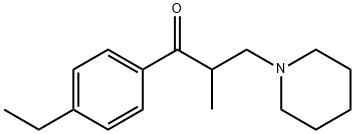Description
Apiresone is a central skeletal muscle relaxant with various pharmacological effects. Animal experiments suggest that eperisone hydrochloride can dose-dependently inhibit decerebral tonic (γ-rigid) and ischemic decerebral tonic (α-rigid) induced by interthalamic transection in rats, and inhibit the stimulation of the dorsal spinal cord in cats with spinal cord injury. The evoked monosynaptic and polysynaptic reflex potentials may reduce the sensitivity of muscle spindles by inhibiting the γ-neuron system.
Pharmacological action
Eperisone is an antispasmodic agent used in the study of disorders characterized by muscle stiffness and pain. It works by relaxing skeletal and vascular smooth muscles, such as reducing muscle tone, improving circulation and suppressing pain reflexes. Eperisone is a centrally acting muscle relaxant that inhibits pain reflex pathways and has vasodilatory effects.
Side effects
Serious adverse reactions include: shock, abnormal liver function, abnormal renal function, abnormal blood picture; the following adverse reactions may occur: skin, rash, itching, etc.; mental nerves, insomnia, headache, drowsiness, body stiffness, numbness of limbs, decreased consciousness, limbs Weakness, unsteady standing, etc.; Digestive system, nausea, vomiting, loss of appetite, stomach discomfort, abnormal liver function, etc.; Urinary system, urinary retention, urinary incontinence, feeling of incomplete urination, etc., occasionally abnormal renal function; systemic symptoms, Fatigue, occasional dizziness, decreased muscle tension, etc.; other, facial flushing, sweating, etc.
Manufacturing Process
To 60 ml of isopropanol, there are introduced 120 g of 4-ethyl-propiophenone,
28.8g of p-formaldehyde and 107 g of piperidine hydrochloride, and the
resulting mixture is heated to reflux on an oil bath with stirring. The heating is
continued, and when the reaction mixture solidifies, the state being a sign of
completion of the reaction, there are added 500 ml of acetone thereinto. The
solidified mass is pulverized by crush, recovered by filtration and washed with
acetone. 144 g of the crude dry crystalline substance is thus obtained, which
is the hydrochloride of the purposed product. The hydrochloride is
recrystallized from isopropanol, and there are obtained the crystalline needles
having the melting point of 170°C to 172°C.


